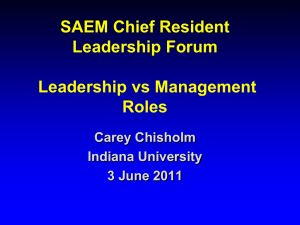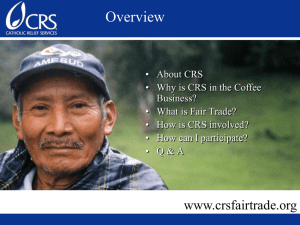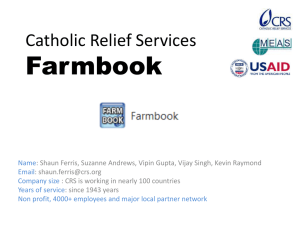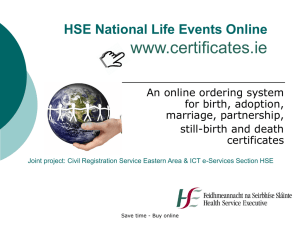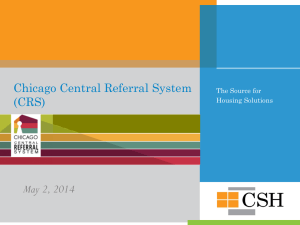Overview of Catholic Relief Services Program in Ghana
advertisement
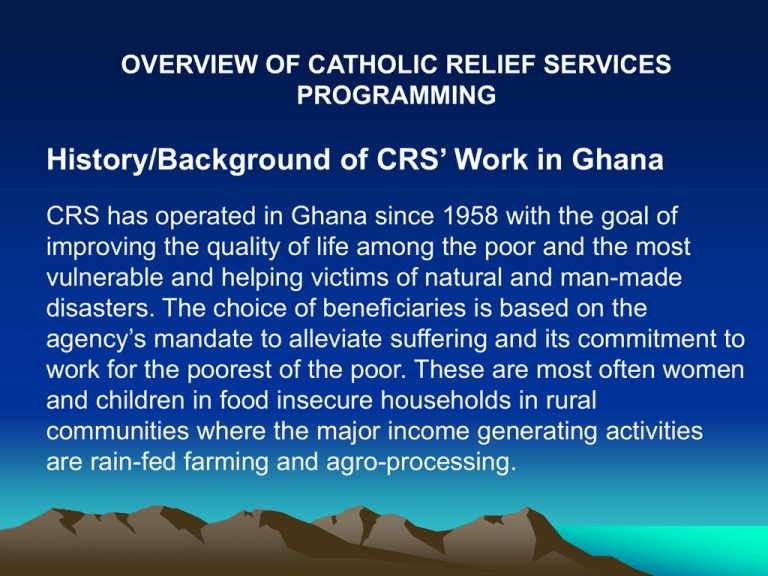
OVERVIEW OF CATHOLIC RELIEF SERVICES PROGRAMMING History/Background of CRS’ Work in Ghana CRS has operated in Ghana since 1958 with the goal of improving the quality of life among the poor and the most vulnerable and helping victims of natural and man-made disasters. The choice of beneficiaries is based on the agency’s mandate to alleviate suffering and its commitment to work for the poorest of the poor. These are most often women and children in food insecure households in rural communities where the major income generating activities are rain-fed farming and agro-processing. History/Background of CRS’ Work in Ghana Cont. To achieve its goal, CRS/Ghana acts as a service and support agency for programs and projects, which are implemented by the Catholic Church, the Government of Ghana and its various ministries, departments and agencies, and other religious and non religious and non-governmental organizations that pursue common development goals. History/Background of CRS’ Work in Ghana Cont. CRS/Ghana has interventions and programs in several development sectors, including Education, Health, Water and Sanitation, HIV/AIDS, Safety Net Initiatives, Peace-Building and Conflict Transformation, and Agribusiness. The three regions in the northern most part of Ghana are cited in the Ghana Poverty Reduction Strategy II as the regions experiencing extreme poverty. History/Background of CRS’ Work in Ghana Cont. These are also the regions with the highest levels of malnutrition and stunting among children, highest child morbidity and mortality rates, lowest school enrollment and completion rates, especially among girls, highest adult illiteracy levels, and the regions with the most recurrent cases of guinea worm and other water-borne diseases. As such, in pursuit of CRS’ global determination to reach out to the “poorest of the poor”, CRS/Ghana made a just decision since 1987 to focus its limited resources in the three northern regions, in all its 34 districts. History/Background of CRS’ Work in Ghana Cont. Working with local church ,government partners, and other NGOs, CRS/Ghana supports development through specific activities or programs as outlined below. School Feeding provides hot meals for pre and primary school children and take home rations for girls to promote enrollment, attendance and retention of school aged pupils. School Health Education Program (SHEP): Recognizing the link between health and school attendance, SHEP promotes appropriate hygiene practices, teaches health education and provides children with deworming tablets twice yearly History/Background of CRS’ Work in Ghana Cont. • Quality Education Improvement Program (QEIP): Improving educational attainment in target schools through improved quality of primary education using methods and activities that are proven to yield results. • Water and Sanitation: Improving access to water and sanitation facilities for participating communities by providing technical and infrastructural support in addition to improving hygiene practices by training community based water and sanitation committees. History/Background of CRS’ Work in Ghana Cont. Agribusiness: Increasing incomes and yield for rural farmers producing selected crops by adding value and facilitating marketing linkages Peace building: Supporting five satellite peace centers throughout Tamale Ecclesiastical Province with training and inputs to mediate and transform conflicts in selected communities. Leprosy Support: Providing targeted hospitals materials and support to improve the care of leprosy patients. History/Background of CRS’ Work in Ghana Cont. • Health Sector: Child Survival: The Child Survival program relies on four key objectives namely: – Improving key household health and nutrition behaviors among mothers of young children – Improving accessibility of health services to rural communities – Improving quality of health services – Increasing utilization of health services History/Background of CRS’ Work in Ghana Cont. INAAM (INTERGRATED NUTRITION ACTION AGAINST MALNUTRITION) This focuses on rehabilitating undernourished children by using quick impact and assets-based approaches at both the community and facility level. These approaches include: Focused Nutrition Intervention (FNI): Facility based treatment of severe child under-nutrition Child Survival Assistance/Targeted Food and EducationEducational support and appropriate food inputsPositive Deviance (PD)/Hearth Approach-Assets based approach that utilizes community based resources to rehabilitate undernourished childrenCentral to the above stated programs is the fact that they all hinge on the behaviour attitude and situations of people. History/Background of CRS’ Work in Ghana Cont. CRS merely facilitates a process to aid the communities/beneficiaries to change their attitudes or behaviours towards a particular action or inaction, which when not checked might generate into situations that negatively affects one or more sectors of their lives. These will then further exasperate an already declining status of wellbeing. Thus cardinal to the successful implementation of all these programs is the effective participation of partners and beneficiaries in accepted behaviour change strategies aimed at improving an identified negative, harmful and sometimes life threatening situation. WHAT IS BEHAVIOUR CHANGE COMMUNICATION (BCC)?? In the context of CRS’ work, we describe BCC as the development of interventions that best empower communities to identify problems, evolve solutions and mobilize resources and skills to address the problems. In the design of BCC strategies, CRS is guided by the Academy for Educational Development’s (AED’s) BEHAVE Framework. BEHAVE employs easy-to-use tools based on principles of behavioral science to make four strategic decisions: WHAT IS BEHAVIOUR CHANGE COMMUNICATION (BCC)?? Cont • Who the primary target groups are that should be reached with BCC • What actions should be taken to change behaviour • what the psychosocial, structural, or other determinants and factors are that make the most difference in the target group’s choice to act • What strategies will be effective in addressing those determinants and factors? Once a BCC strategy is determined, it is further scrutinized and categorized into the following 3 main purposes. Instruction: This is communication designed to improve skills e.g. how to wash hands, or brush teeth, how to prevent guinea worm infection, how to breast feed exclusively Advocacy: Communication for removing environmental constraints e.g. socio-cultural factors or norms that affect hygiene promotion and education, exclusive breast feeding, high taxes that make mosquito nets too expensive for people to buy. Promotion/Counseling: -Communication designed to change ideational factors e.g. knowledge, attitudes (belief & values), perceived risks, social influence, emotions etc. School Health Clubs • School health clubs have been formed in all SHEP schools. It comprises of a membership of twenty pupils-10 boys and 10 girls with 5 pupils each selected from primary 2 to 5 who have expressed interest and enthusiasm in promoting personal and environmental hygiene issues. Roles • • • • • Supervise and encourage school cleanliness Help make the school an attractive place through proper landscaping Promote gardening and tree planting Monitor and help implement the school health education program through assisting teachers during regular inspections, games and drama etc. Look after food cleanliness of food vendors in the school/ Supervise and encourage food vendors to promote the safety of food sold to pupils by vendors on the school compound Roles • • • • Ensure that water used in the school is clean and safe and that children adopt clean methods in its usage Help eliminate mosquito breeding places in/near school Make up health quizzes and health checklist and try them out/Conduct quizzes and institute the use of a checklist to improve upon the knowledge base and bring about positive behavior change in their peers Carry out any other related school health activities as may be determined by the school health teacher in consultation with the rest of the staff... COMMUNITY SCHOOL HEALTH MANAGEMENT COMMITTEES • As a way of linking and improving community involvement in School Health activities; Community School Health Management Committees have been formed and trained in all CRS/SHEP schools/communities. CRS BCC STRATEGIES CRS’ program activities are focused on supporting communities to become actors of their own development rather than being passive recipients of information. School children and community members are supported with knowledge and analytical skills through life skills based education and rights based approaches and trainings to enable them assess their situation, analyze the causes of the problems identify and develop appropriate responses and actions based on their community specific needs towards solving these problems. The key BCC strategies/activities most frequently employed are: INSTRUCTION - Communication designed to improve skills e.g. how to wash hands properly with soap Hygiene and sanitation education • • • • • Nutrition education Environmental education Sensitization Demonstration Development and use of Health guides and other teaching/learning materials • Wall/pocket calendars • Posters • Child to child • ADVOCACY - Communication for removing environmental constraints • Community sensitization and meetings • Trainings • Health Talks • Radio Broadcast • Drama • Focus group discussions using appreciative inquiry-best practices. • Handouts • Incentives-wheel barrows, hand washing containers • Child to child Promotion/counseling -Communication designed to change ideational factors e.g. knowledge, attitudes etc. • Drama, role play • Quiz Competitions • Health campaigns • Health walks/circle of assessment • Games • Posters Monitoring to enforce desired behavior change: CRS has designed monitoring tools for the program and this is to enforce hygiene behavior. One remarkable feature of the program is that Community members assist in personal hygiene inspection, health talks and children growth monitoring activities. Social Mobilization: This brings together all feasible and practical intersectoral social allies to raise people’s awareness of and demand for the behaviour change being sought; to assist in the delivery of resources and services; and to strengthen community participation for sustainability and self reliance. The above is done through regular meetings with GHS and GES officials and sensitization of selected communities to discuss roles and responsibilities of the specific program. Capacity Building/Training: BC is a highly sensitive and difficult activity CRS provides both the facilitator and the beneficiary with rigorous training to appreciate each other’s role in this joint venture. Furthermore behavioral science is a dynamic field of study with new findings published every so often. CRS deems capacity building as absolutely crucial to the successful implementation of any BCC. PRA/PLA Tools: To aid the identification of problems, design appropriate BCC and to ensure active participation of community members in the process, various participatory approaches are employed Participatory Hygiene and Transformation Tools (PHAST): knowledge and tools from PHAST methodologies are adapted for various BCC strategies across all sectors in the development of relevant and appropriate target strategies. Appreciative Inquiry: Recognizing that beneficiaries have a lot of potential and a assets CRS usually employs AI to build on these local-based assets in the development of appropriate BCC strategies. Regular review/Assessment meeetings: BCC strategies are constantly reviewed to ascertain its relevance, impacts and acceptance by beneficiaries. These reviews and assessments are usually conducted with expert consultants in BCC and behavioural science. Establishment/ Working through Structures: For continuity and sustainability CRS and partners (GES/GHS/Community) has put in place structures to make its BCC strategies more effective. Some structures established within beneficiary communities include: •School Health Clubs •Community School Health Management Committee •Community food Management Committees •Mothers Clubs •Watsan Committees •Community Volunteers attached to outreach clinics •Regional and district GES/CRS Partner supervisors In addition to these CRS-established structures, CRS also works with already government established structures such as SMC/PTAs, Regional and District SHEP coordinators, Environmental officers, District water and Sanitation Teams (DWSTs), Community Health Nurses, District Health Management Teams (DHMT) Assemblypersons, area Council /unit Committee members, chiefs, religious leaders magazias and other community leaders. IMPACT ACHIEVEMENTS PERCENTAGE OF PUPILS WHO DEMONSTRATE AND PRACTICE APPROPRIATE HYGIENE BEHAVIOUR Baseline 2003 2006 (Target) 2006 (Achieved) 42.8% 47.8% 79% Percentage of pupils in program schools who consume de-worming medication twice per year Baseline 2003 0 Target 2006 85 Achieved 2006 86 Indicator # of Girls enrolled in program Schools Baseline 2006 44,388 Target 2006 Achieved 2006 48,827 53,700 # of Pupils enrolled in Program schools (boys&girls) 150,145 157,650 171,240 % increase in attendance of pupils (boys & girls) 24.6 50 59.3 Indicator % increase in girls’ attendance Baseline 2006 Target 2006 Achieved 2006 24.5 55 83 % of teachers in program schools 78.0 effectively planning their lessons % of teachers in program schools using 19.7 pupil-focused instructional practices - 97.0 - 62.4 Indicator % of teachers in program schools using effective classroom management techniques % of teachers in program schools using improvised TLMs in teaching % of Communities active in School decision-making Baseline 2006 Target 2006 11.0 - 39.0 - 35 50 Achieved 2006 50.3 71.5 65 Indicator % of Communities implementing activities/projects to improve quality of education Baseline 2006 Target 2006 Achieved 2006 27 53 93 Nutritional Status of Children under 5 years STUNTING DISTRICT BASELINE 2004 MID-TERM 2006 Moderate Severe Moderate Lawra Lawra East Mamprusi 19.6% 7.6% 21.8% 11.2% 3.7% 19.7% Severe Moderate East Mamprusi 16.7% 25.3% 7.4% 15.4% 18.9% 7.7% Severe Saboba Saboba Moderate Bongo 24.8% 15.9% Severe Moderate Severe Bongo Wa Wa 11.8% 20.9% 20.3% 9.3% 8.5% 16.9% Nutritional Status of Children under 5 years WASTING DISTRICT (Indicator) BASELINE 2004 MID-TERM 2006 Moderate Severe Moderate Severe Moderate 11.7% 2.9% 8.3% 7.2% 16.0% 10.7% 1.5% 5.0% 1.5% 8.9% 2.1% 0% Lawra Lawra East Mamprusi East Mamprusi Severe Saboba Saboba Moderate Bongo 11.5% 10.3% Severe Moderate Severe Bongo Wa Wa 2.5% 12.6% 3.8% 0.9% 6.7% 0% Indicator Exclusive Breast feeding at 6 months District Baseline Mid-term 2004 2006 Lawra 12.4% 64.0% East Mamprusi 22.4% 52.4% Saboba 12.0% 85.7% Bongo 16.2% 85.7% Wa 17.0% 25.0% Usage of Household Latrines Year # of Communities Household Latrines Family Size 2005 7 70 420 2006 13 494 2,964 2007 19 500 3,000 SUCCESS STORIES • 1. Adaboya School/community: The School Health Club action plan had contribution of shea nuts as an activity. All children willingly contributed and money used to purchase 10 cartoons of soap and the rest used to buy shares in the Bongo Community Bank • 2. Feo SHEP Club constructed a urinal whilst community provided coaltar for painting. School Health Clubs engaging in income generating ventures like basket/hat weaving to support SHEP activities SUCCESS STORIES • 3. SHEP Club members asking for land from opinion leaders for farming purposes to sustain the program • 4. SHEP teachers integrating the program into capitation grants by adding provision of soap to their School Performance Improvement Plan • 5. As a result of effective animation, the communities of Langbinsi and Namangu in the East Mamprusi district have evolved a good maintenance strategy ( by employing young girls who keep registers of money collected on water fetched) by collecting token amount of money on each bucket of water collected and saving it at the bank to yield profit. Use of the money to purchase spare parts for maintenance SUCCESS STORIES • 6. A Community Health Volunteer through her active involvement in CRS health program by working with nurses and keeping of good records, finally gained admission into the Nursing school • 7. Mothers (lactating and pregnant) attend clinics regularly even though food incentives given has ceased • 8. Mothers of malnourished children are learning from mothers of well-nourished children how to combine locally available food commodities to ensure that their children grow strong and healthy CHALLENGES • • • • • • • • Post –intervention assessment Dissemination of information to the larger community Target and coverage (scope) Ineffective coordination among stakeholders (NGOs and District assemblies) Volunteerism fatigue (motivation, migration, etc) Lack of clear-cut policy directives e.g. SHEP Enforcement of bye-laws Inadequate funding LESSONS LEARNED • • • • • • • Collaboration /consultation with key partners helps in synchronizing activities For greater impact and success involves direct beneficiaries in programme planning information and assessment. Capacity-building is a key tool Behaviour change is a process – it takes time to see the impact Hardware and Software leads to total behaviour change (improved health) Total coverage enhances behaviour change “A good cloth sells itself”. Here good work promotes itself Thank You •CRS Tamale
